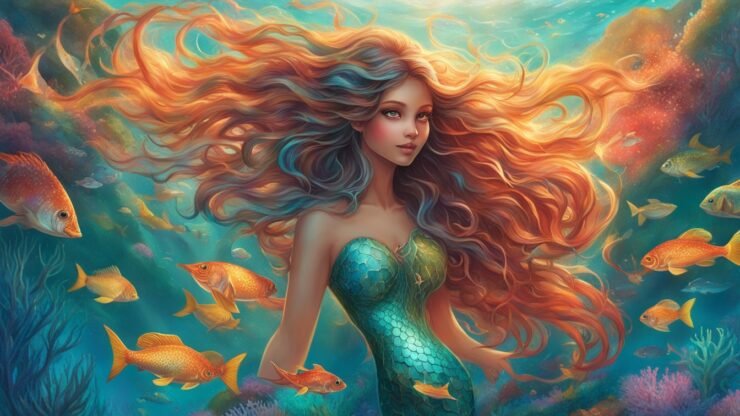In the depths of Philippine seas, where waves whisper secrets, a captivating tale takes form. It’s the legend of the Sirena, mythical aquatic beings. These beings have enchanted the Filipino people for generations. As the sun sets, its glow casts a golden light on coastal villages. This is when stories about these enchanting creatures come alive, creating a diverse tapestry of Filipino mythology.
According to legend, the Sirena are both beautiful and have voices that mesmerize. They’ve always been seen as the guardians of the seas. They protect coastal communities and help seafarers find their way through dangerous waters. Their stories are part of Filipino culture, with tales that have been told for centuries. Each story adds to the captivating narrative.
Exploring the legends of the Sirena shows us a world filled with mystery and wonder. Here, the lines between the natural and supernatural are blurred. The secrets of the sea are protected by these mythical beings. Their story dates back to pre-Hispanic times. Even today, they remain a key part of Philippine culture. The tale of the Sirena highlights the resilience and depth of Filipino mythology.
Key Takeaways
- The Sirena are captivating mythical aquatic beings that are central to Filipino folklore and mythology.
- These creatures are believed to be guardians of the seas, protecting coastal communities and guiding seafarers.
- The legends and stories surrounding the Sirena are deeply woven into the cultural fabric of the Philippines, with a rich history and diverse representations.
- Exploring the Sirena’s origins, symbolism, and role in Philippine culture can provide insights into the country’s Filipino mythology and its connections to the natural world.
- The enduring fascination with the Sirena highlights the importance of preserving and promoting the Philippines’ mythological heritage.
Introduction to Filipino Mythology
Filipino mythology holds a variety of myths and legends. They come from oral traditions and written tales across the Philippines. The stories of Filipino folklore began in pre-Hispanic times. They were later shaped by different cultures and religions.
Rich Tapestry of Filipino Folklore
Before Christianity and Islam, the Philippines embraced animism and shamanism. These pre-Hispanic influences are key to understanding Philippine mythology. They gave rise to captivating stories that are at the heart of the culture.
Influence of Pre-Hispanic Beliefs and Traditions
Filipino folklore traces back to pre-Hispanic beliefs and traditions. Over time, these traditions blended with other cultural and religious practices. Before major world religions, animism and shamanism shaped the nation’s view of the world. They laid the foundation for Philippine mythology as we know it.
Sirena: The Enchanting Aquatic Beings
Sirena are a captivating group in Filipino mythology. They are seen as beautiful women with fish tails. These creatures live in the deep waters around the Philippines.
The myths highlight their attractive voices that lure fishermen. The Sirena’s songs can lead sailors to danger. They have a human upper body and a fish tail, like mermaids.
Legends say Sirena may harm those who worship certain gods. A TV series showed Dyesebel, a famous Sirena. It included her adventures with sea creatures.
The Sirena’s roots go back to ancient Greece. They appeared in Homer’s “Odyssey.” Their name comes from a Greek word meaning to bind, which fit their power to charm sailors.
Their songs are said to lead sailors astray. This makes them symbols of feminine charm and danger. The idea appears in various cultures, including Homer’s “The Odyssey.”
| Mythological Connection | Significance |
|---|---|
| Hans Christian Andersen’s “The Little Mermaid” | Explores themes of sacrifice, desire for transformation, and unrequited love through a mermaid princess. |
| Irish folklore Merrow mermaids | Depicted as benevolent beings with the ability to live on land, symbolizing dual existence and identity. |
| The Harpies in Greek mythology | Contrast the Sirens by embodying chaos and disorder, emphasizing the multifaceted nature of mythological beings. |
Art, music, and literature have drawn from Sirena’s tales. They stand as symbols of allure and inspiration. Their legend keeps the spirit of Philippine mythology alive.
Origins and Cultural Significance
The Sirena’s origins come from the early beliefs of Filipino people. They have a strong link to the sea and its world. This creature is a key part of the Philippines’ maritime culture. It’s seen as a spirit of the seas and a protector of coastal areas.
Connection to Philippine Maritime Culture
In Philippine stories, the Sirena is important. It shows the deep link between the country’s maritime culture and beliefs. Known as protectors, these sea creatures look after the seas. They keep coastal residents, fishermen, and sailors safe.
The Sirena symbolizes the Philippines’ strong connection to the sea. It proves the ongoing importance of Philippine maritime culture.
Symbolism and Representations
In Filipino tales, the Sirena’s symbolism is rich and meaningful. It stands for femininity, beauty, and the mix of the natural and supernatural. These etched in myths are often seen as beautiful yet powerful. They can both help and harm, showing the complexity of mythology.
Physical Characteristics and Abilities
In Filipino mythology, the Sirena are seen as stunning creatures. They have the top of a human and the bottom of a fish. Many stories describe them as beautiful, adorned with long, shiny hair and scales that gleam. Their voices are said to be so lovely, they can draw people in.
Mythologies highlight their powers too. They can change shape, manage the sea, and lead travelers astray with their songs.
Descriptions from Various Mythological Sources
The earliest siren text with a fish tail appears in a book from the 7th to 8th century. Over time, especially in medieval stories from France, sirens were often shown as part woman, part fish. This mix of bird, woman, and fish likely stemmed from different mythic traditions.
The Sirena is similar to the alluring sirens in Greek tales. These sirens used their songs to enchant those who sailed by. The connection between these myths shows a long-standing interest in mystical beings that are part human, part animal.
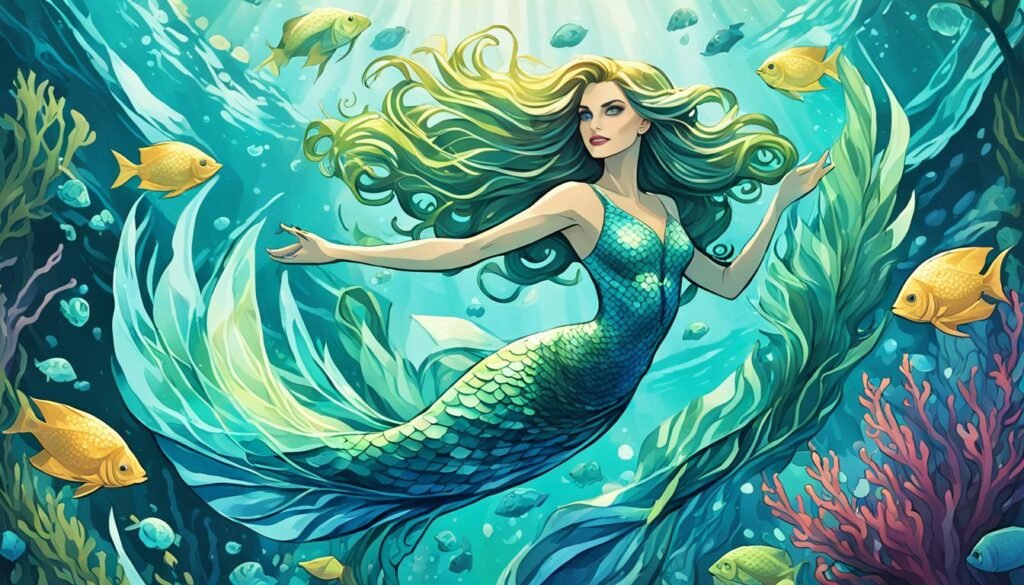
| Mythological Source | Description of Sirena/Siren |
|---|---|
| Liber Monstrorum de diversis generibus (7th-8th century) | Earliest known text describing the siren as fish-tailed |
| Physiologus (9th century) | Sirens illustrated as “woman-fish,” or mermaid-like, despite being described as bird-like in the text |
| Greek Mythology | Classical sirens known for using their beautiful song as a lure to attract seafarers |
| Teutonic Myth | Sirens seen as alluring beings that could be part bird or part fish |
Sirena’s Role in Folklore and Legends
The Sirena are mystical sea creatures in Filipino stories. They are seen as protectors of the sea. These enchanting beings help fishermen and others who live by the sea.
Protective Spirits of the Seas
The Sirena are heroes in many stories, watching over the sea. They make sure people at sea stay safe. They help lost sailors and warn of dangers, like storms.
Tales of Sirena Encounters
There are tales of friendly and not so friendly Sirena encounters. Some stories talk about the friendship between Sirena and humans. But, there are also stories of the danger of facing these mythical creatures.
The Sirena’s story is especially beloved in Chamorro culture. This tale shows the strong connection between parents and children. The Sirena’s story is loved by people from the Philippines and all over the world.
Sirena in Contemporary Philippine Culture
The beauty of Sirena, mythical creatures from Filipino stories, is still alive in the country’s art and literature. They have become famous in various creative works, captivating audiences worldwide.
Depictions in Literature and Art
In modern Filipino literature, Sirena tales are a must, from novels to poems. These stories show the mystery and magic of these beings, touching on themes of change, duality, and our link to the supernatural.
Works like Marina and Dyesebel to Gloc 9’s “MKNM: Mga Kwento ng Makata” celebrate Sirena. This shows their lasting impact on Filipino culture.
Artists also love reimagining Sirena, whether on canvas or in film. Their beauty and mystery inspire rich, varied art forms. This shows how much Filipinos cherish these mythical sea maidens.
Tourism and Cultural Events
Places tied to Sirena myths are now top spots for tourists and locals alike. These spots, rich in lore, welcome visitors keen on myth and adventure.
Moreover, festivals celebrating Sirena, with their parades and art, are now Philippine traditions. They help keep Sirena legends and their magic alive in the country’s heart.
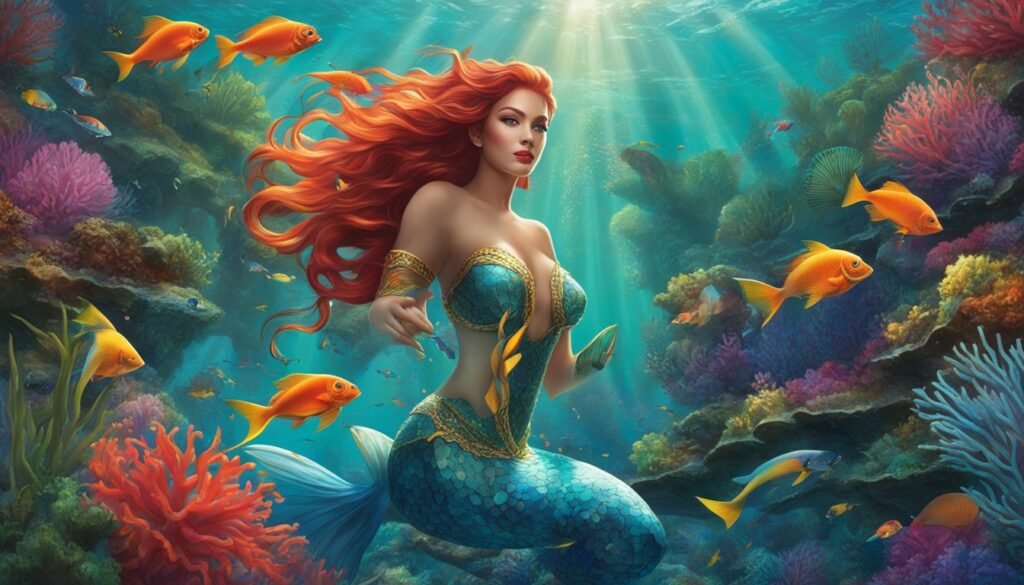
Sirena’s place in the Philippines’ modern culture proves the lasting magic of folklore. From books to the big screen, they continue to enchant us. This ensures Sirena will remain a cherished part of the Filipino identity for ages.
Variants and Related Mythological Creatures
The Sirena in Filipino lore are quite unique but also have things in common with creatures from other places. This piece looks at how the Sirena and the Siren in Greek tales are alike. They are both beautiful and live in water, drawing sailors to danger.
It also connects the Sirena to the mermaids in many cultures. These links show how stories often talk about change, opposites, and the special link between people and the sea.
Siren in Greek Mythology
The idea of mermaids as lovely, songful beings might have come from Greek myths. Their sirens, once half-bird but later half-fish, had voices that could captivate. They, just like the Sirena in Filipino stories, led sailors to unfortunate ends.
Mermaid Legends from Around the World
Stories of the Sirena find company with mermaid tales worldwide, from Europe to Asia and Africa. These legendary beings, looking like beautiful women but with a fish’s tail, are found in many cultures’ stories. They inspire art, opera, and more, linking us to the sea in a special way.
| Mythological Creature | Cultural Origin | Key Characteristics |
|---|---|---|
| Sirena | Filipino Mythology | Beautiful women with fish-like tails, known for their enchanting voices and ability to control the seas |
| Siren | Greek Mythology | Half-bird, half-fish creatures with captivating voices that lured sailors to their demise |
| Mermaid | Worldwide Folklore | Aquatic beings, often portrayed as beautiful women with fish-like lower bodies, found in the folklore of many cultures |
These creatures, from tales the world over, speak to our shared interest in the ocean’s mysteries. They show how storytelling helps us understand our place next to nature.
Preservation and Promotion of Filipino Mythology
Filipino mythology weaves many stories, with the Sirena as a standout figure. These stories are vital for the culture and identity of the Philippines. In the modern world, it’s crucial to keep these myths alive. Various groups are working hard to record, research, and share these legends.
Efforts by Cultural Organizations
The National Commission for Culture and the Arts and the Komisyon sa Wikang Filipino are leading the way in protecting Filipino myths. They’re documenting the vast array of tales from across the Philippines. Their work ensures these cultural treasures endure for the next generations.
Groups like the Philippine Folklore Society and the Sentro ng Wikang Filipino play a big role too. They focus on learning and teaching about Filipino myths. Through research and teaching, they’re spreading the word. This helps people understand the value of keeping these stories alive.
Importance of Passing Down Oral Traditions
Preserving Filipino mythology also depends on local communities. Elders often share stories of the Sirena and other myths with the younger generations. This keeps the tales alive year after year.
Now, in many parts of the Philippines, folklore is still a common topic. This happens more outside big cities. Graduates also often include local myths in their work. It shows that interest in these stories is growing.
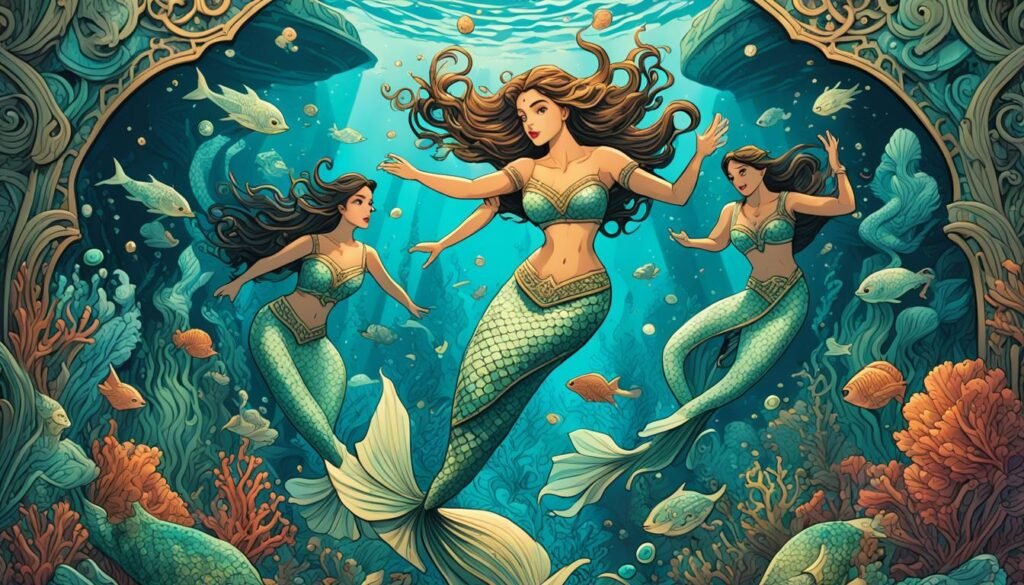
Still, it’s tough to preserve these oral traditions today. Keeping myths true to their original form in a changing world is a big challenge. It requires teamwork from cultural groups and the public. Together, they can succeed in facing these challenges.
Mythological Influences on Philippine Society
Filipino mythology is like a beautiful, intricate design. It’s full of stories about the fascinating Sirena. These stories have deeply touched many parts of Philippine life. They influence how people practice religion, their culture, and traditions.
Reflections in Beliefs and Practices
Different Philippine groups follow a mix of beliefs and practices. Many have roots in stories passed through the ages. These tales often guide how Filipinos think about the unseen and spiritual worlds.
The way people respect nature connects to these stories too. They believe in powerful, unseen forces in nature. This leads them to honor nature spirits and gods from myths. Thus, they are encouraged to care for the earth and use its resources wisely.
Ecological and Environmental Connections
Philippine myths are closely linked to the country’s natural settings. Tales of the Sirena and other creatures show respect for the seas and coasts. They teach about the importance of protecting these areas.
These stories also warn about harming the environment. They remind people to treat nature with respect and care. In this way, mythology inspires efforts to conserve and protect the environment in the Philippines.
Sirena in Popular Culture
The Sirena are still very popular today. They show up a lot in movies, TV shows, and art, both in the Philippines and around the world. These mythical sea creatures have inspired many creative people to tell their stories in various media types.
Representations in Film and Television
The Sirena are famous in Filipino movies and shows. Sometimes, they are the main characters or have important roles. For instance, the Dyesebel series first appeared in 2008 and was about a mermaid exploring the human world in a 125-episode series. Also, the show Marina in 2004 featured a mermaid as the lead, showing how much these aquatic beings interest people in the Philippines.
Merchandise and Collectibles
Because of their popularity, there’s a lot of Sirena stuff you can buy. This includes things like figures, toys, clothes, and more. These items are very popular with buyers in the Philippines. They help keep the legend of the Sirena alive and let people learn about the country’s rich myths.
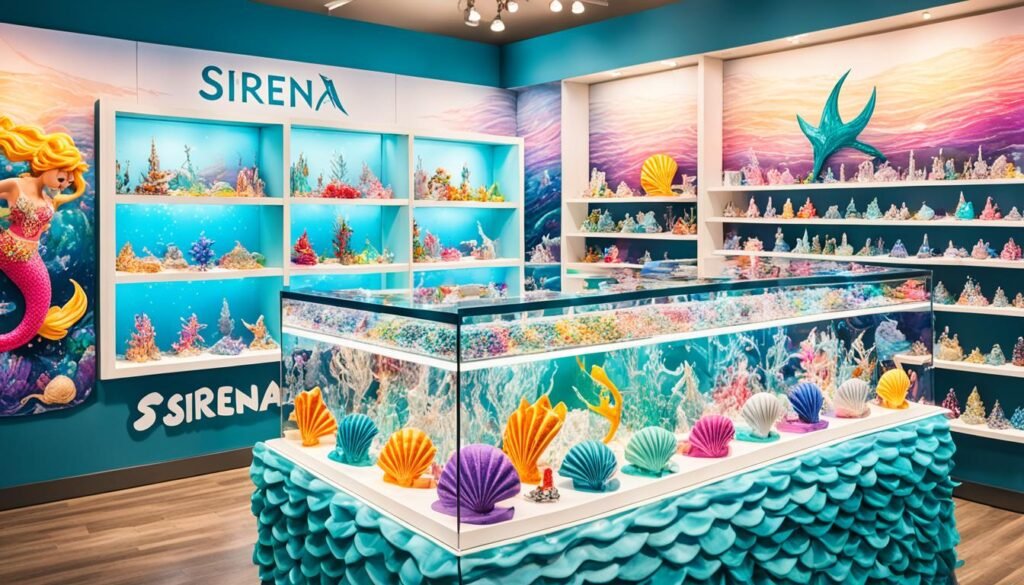
Scholarly Research and Academic Studies
Filipino mythology, especially the tales of the Sirena, has intrigued many experts. These include scholars and researchers from different fields. They focus on exploring anthropological and folkloric research on the Sirena. Through their scholarly studies, we gain deeper knowledge about the cultural significance and historical origins of these mythical beings.
Anthropological and Folkloric Perspectives
The Sirena have been looked at closely from anthropological and folkloric perspectives. Researchers show us how these aquatic beings are key to Filipino culture. Publications discuss what the Sirena mean and their part in maritime traditions and old beliefs. This academic work helps us understand why the Sirena matter in Filipino myth and culture.
Literary and Cultural Analyses
Besides the earlier research, literary and cultural analyses focus on the Sirena too. Scholars look into how mythological creatures are shown in Filipino stories, art, and cultural tales. They discuss the symbolic and thematic representations that have developed over the years. Such academic studies tell us why the Sirena remain captivating and their effect on the Filipino mind.
| Scholarly Articles | Key Findings |
|---|---|
| 54 articles on COVID-19’s impact on contraception experiences (2021) | Explored the challenges faced by reproductive-aged women in accessing contraceptive care during the pandemic. |
| 15 articles predicting COVID-19 vaccination likelihood among reproductive-aged women (2022) | Examined factors influencing vaccine hesitancy and uptake in this population, informing targeted outreach efforts. |
| 13 articles studying time-use activities and depressive symptoms among older Mexican adults (2020) | Identified the impact of pandemic-related disruptions on mental health and well-being of older Mexicans. |
| 9 articles on prenatal and postpartum telehealth visits during COVID-19 (2023) | Assessed the quality of virtual care and patient preferences for future maternity care delivery models. |
| 6 articles on contraceptive care in the US during the COVID-19 pandemic (2023) | Highlighted the need for innovative strategies to ensure continuity of essential reproductive health services. |
These scholarly articles and academic studies greatly enrich our understanding of the Sirena. They demonstrate the enduring significance of these creatures in Filipino mythology and culture. With a focus on anthropological, folkloric, literary, and cultural dimensions, they light up the rich tapestry of Philippine folklore and traditions.
Mythological Tourism and Destinations
The Sirena, mythical beings in the Philippines, have sparked a lively mythological tourism sector. Various sites are known for their association with these sea creatures. They have turned into sought-after spots, enriching the tourism scene. These places allow people to delve into the nation’s deep cultural myths.
Sites and Landmarks Associated with Sirena
The Siren’s Grotto, in the waters off Siquijor Island, stands out. It is said to be a home for the Sirena. Here, visitors can enjoy swimming with mermaid tail props next to big Sirena statues. The Mermaid Cove in Palawan is also very famous. Known for its clear waters and beautiful rocks, it is thought to be a place the Sirena love.
Festivals and Celebrations
The Philippines celebrates the Sirena with various festivals and celebrations. The Dinagyang Festival in Iloilo City is one of these. It features a lively parade with dancers dressed as the Sirena. The Mermaid Festival in Boracay is another. It includes mermaid-themed activities and contests. These events are fun for tourists and help keep the Sirena’s myth alive in the nation’s culture.
| Sirena-associated Destinations | Notable Features |
|---|---|
| Siren’s Grotto, Siquijor Island | Submerged caverns believed to be the Sirena’s home, offering visitors the chance to swim alongside life-sized Sirena statues. |
| Mermaid Cove, Palawan | Crystalline waters and rocky outcroppings that are said to be a favorite haunt of the Sirena. |
| Dinagyang Festival, Iloilo City | Annual festival featuring a vibrant parade with elaborately costumed dancers portraying the Sirena. |
| Mermaid Festival, Boracay | Celebration showcasing mermaid-themed events, performances, and competitions. |
Comparative Analysis with Other Mythologies
The Sirena are unique to Filipino mythology. Yet, they are not completely different from mythological creatures in other parts of the world. A comparative analysis shows interesting similarities and differences between the Sirena and other aquatic beings. This includes creatures like the Siren in Greek mythology and mermaid tales in different cultures.
Similarities and Differences
The Sirena and the Siren both capture a magical, mythological appeal. They use their voices in the water to attract people. However, the Sirena are usually known as helpful spirits. The Siren is often seen as a negative force that leads sailors to danger.
Also, how these creatures are imagined has changed over time. The Siren went from a bird-headed woman to a half-fish mermaid. Meanwhile, the Sirena have always had a part-fish, part-human form.
Cultural Exchanges and Influences
Similarities between the Sirena and other mythological figures suggest cultural interactions in the past. The true meaning behind the word “siren” is still debated. Some believe it relates to binding people with magical songs. This shows how stories from different cultures may be connected.
Also, the shared roles and symbolism of these creatures hint at their universal appeal. They’re linked to maritime life and represent both good and bad aspects. This shows how these stories are enjoyed and understood across the world.
Conclusion
The Sirena plays a huge role in Filipino mythology. They capture the hearts of Filipinos and people worldwide. This shows how deeply the country’s culture is rooted.
Protecting and sharing these mythical stories is vital. We must keep the Sirena alive in our culture for our children’s children. In a changing world, this keeps us connected to our past and traditions.
The Sirena’s stories are not old tales. They inspire modern art and culture too. They bridge the past and the present, making the Philippines’ cultural heart beat strong.
FAQ
What are Sirena and what is their significance in Filipino mythology?
What are the origins and cultural significance of Sirena in Filipino mythology?
What are the physical characteristics and abilities of Sirena as depicted in Filipino mythology?
How are Sirena represented in Filipino folklore and legends?
How are Sirena represented in contemporary Philippine culture?
How do Sirena compare to similar mythological creatures from other cultures around the world?
What efforts are being made to preserve and promote Filipino mythology, including the legends of Sirena?
How have the Sirena and Filipino mythology influenced Philippine society and culture?
What is the significance of Sirena in the realm of scholarly research and academic studies?
How has the fascination with Sirena led to the development of a mythological tourism industry in the Philippines?
Source Links
- https://artsequator.com/southeast-asian-horror/
- https://en.wikipedia.org/wiki/Sirena_(Philippine_mythology)
- https://mythicalcreatures.info/characters/sirena/
- https://en.wikipedia.org/wiki/Mermaid
- https://www.guampedia.com/sirena/
- https://peterbreboneria.com/the-sirena-in-the-philippines-asemiotic-analysis-of-lgbt-discrimination-and-correlated-highest-suicide-rate/
- https://neocha.com/magazine/from-lore-to-art/
- https://strawpoll.com/most-popular-myth-philippines
- https://en.wikipedia.org/wiki/Philippine_mythology
- https://scholar.google.com/citations?user=PTM81rEAAAAJ&hl=en
- https://academic.oup.com/aje/advance-article-abstract/doi/10.1093/aje/kwad108/7146382
- https://hemisphericinstitute.org/en/enc09-work-groups/item/336-09-activism-beyond-citizenship-and-the-state.html
- https://www.shimajournal.org/issues/v12n2/r.-Porter-Luck-Shima-v12n2.pdf
- https://en.wikipedia.org/wiki/List_of_reportedly_haunted_locations_in_the_Philippines
- https://en.wikipedia.org/wiki/Siren_(mythology)
- https://bodipaulitics.wordpress.com/2016/07/25/critical-essay-1-sirena/

